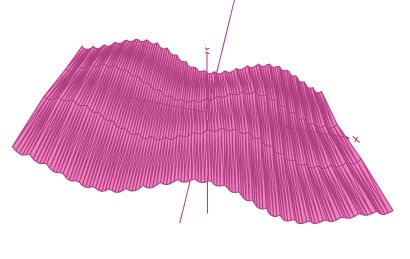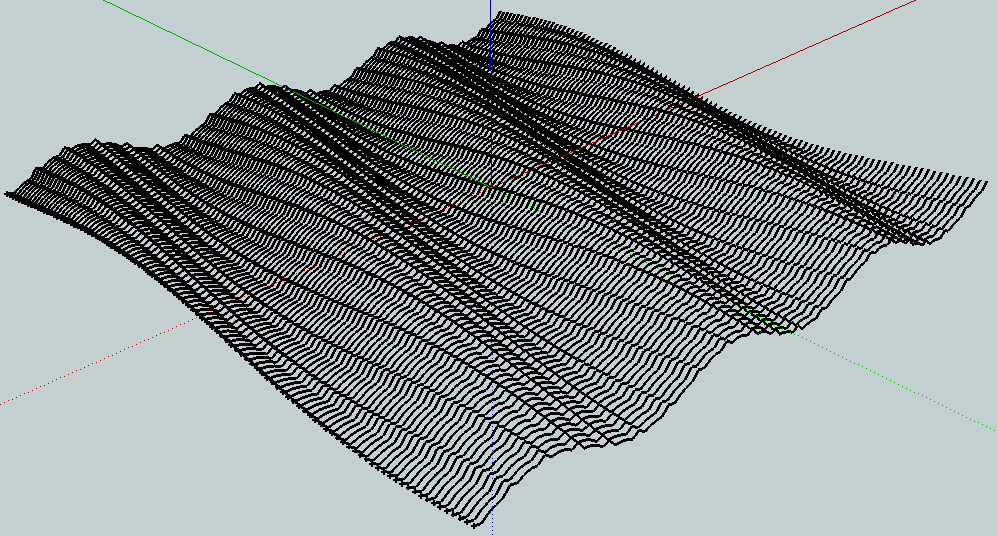Is it possible to model this material in sketchup?
-
ah ha! knowing that helps a lot! especially when using FFD to distort flat shapes smoothly and accurately. Great to know that, thanks!
-
@skaught said:
looks damn good! There are a few different variations of this material and your model looks pretty much exact to a # of them. If you scroll down this link you can see some of the ones that match.
It's a pretty bada$$ product.
How did you do it?
skaught,
(sorry for the delay.)
Here is a model explaining how it can be done with only SU + sandbox tool.
The technique is simple but laborious.
One note. With the smoove tool you can input an offset. But unlike with other tools you type the value first and then release the mouse button.
See this model in 3DW:
http://sketchup.google.com/3dwarehouse/details?mid=68b60c0a964174c5b2dd3120ca5e0662Wo3Dan
-
Your material may be approximated as the sum of two types of waves, the big ones and the tiny ones.
The big ones are a sin function, while the small ones have some cusps.
I wrote a formula for your material:z = ( ((x-floor(x))*2 - 1)^2 - 1 )/3 + 1 * sin(x/2 - y/6)
it reproduces the dunes of your material,
you can have a look at the result in the image or by going to
http://www.archimy.com/ and pasting the codetmin = -12 tmax = 12 tgrid = 2000 x = t z = ( ((t-floor(t))*2-1)^2 - 1 )/3 + 1 * sin(t/2 - y/6)["Floor" stands for the "bigger integer number less than"]
You can change the numbers to tune the result:
z = ( ((t-floor(t))*2-1)^2 - 1)/3 + sin(x/2 - y/6) * 1y/6 -> change the 6 to change the angle between waves
( ((t-floor(t))*2-1)^2 - 1)/3 -> change the 3 to change small waves height
1 * sin(x/2 - y/6) -> change the 1 to change big waves height
x/2 -> change the 2 to change the ratio between small and big wavesYou're allowed to use decimal numbers.
I dont know how to draw a graph in SU.
Hope this helps.

-
I can imagine some improvements to the function but
I didnt want to make things too involved. -
holy crap I have a lot to learn...
will be back!
edit: I seems a little ridiculous to just keep saying thank you again and again...but damn, thank you again. I guess I can't really say I'm teaching myself this program anymore.
-
too late. lol
-
-
@guzman tierno said:
I dont know how to draw a graph in SU.
This might not be exactly what you are looking for, but Jim Foltz wrote a plugin that allows you to generate 2-D graphs in SU. It is called "eq_grapher.rb", and you can get it from the Ruby Library Depot (http://www.crai.archi.fr/RubyLibraryDepot/Ruby/em_edi_page.htm). The script iterates in x only, but it can be extended to sweep both x and y coordinates or even a parametric variable (look at method self.graph), thus accomplishing what you want.
I took the liberty to modify the script to do this in 3D in case you guys are curious. And here is a sample output.

The script can certainly be improved, but then this might be a subject for the scripting forum

Juan
-
Wow, that is a very cool script you made there Juan.
I don't know if there are a lot of Rhino users here, but if Ruby can do 2d/3d graph curves, maybe a graphical algorythm plugin could be made for SU, much like the Grasshopper plugin for Rhino, which is an amazing tool in the right hands and a wonderful solution to do parametric organic architecture.
The cool thing about Grasshopper is that you are doing 'non destructive' modeling, meaning that your organic skyscraper can be controlled by changing parameters (for instance a 2D vector image to control openings in your facades etc...)
Link:http://grasshopper.rhino3d.com/ -
Wow jzer7, that's actually a very cool script, thanks.
-
Thanks.
I forgot to mention, I put a better version of it in the Scripting forum (Plugin - Surface Plotter). Among other things it fills in the surfaces bounded by the lines. I am also working on a plugin that can do parametric surfaces (like spheres, spirals, etc.)
Advertisement









